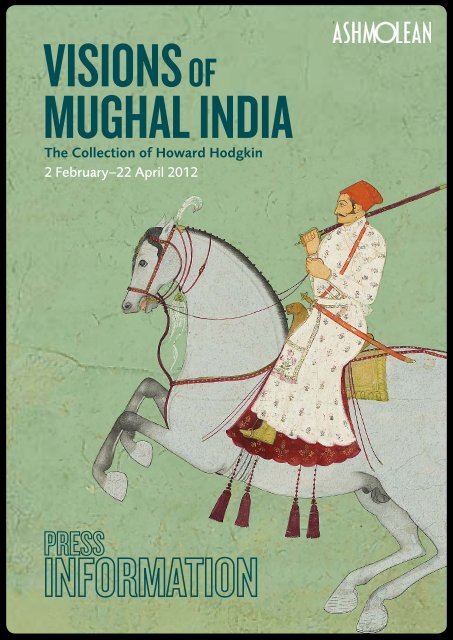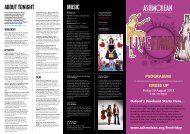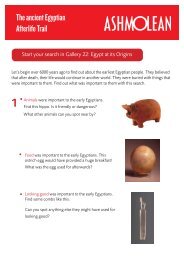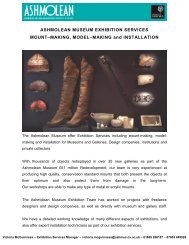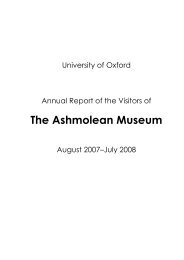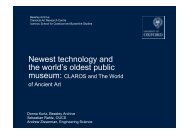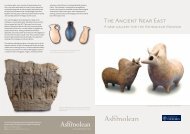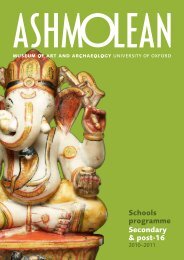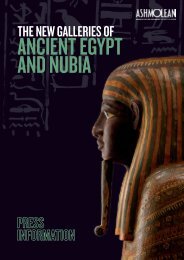visions of mughal india - The Ashmolean Museum
visions of mughal india - The Ashmolean Museum
visions of mughal india - The Ashmolean Museum
- No tags were found...
Create successful ePaper yourself
Turn your PDF publications into a flip-book with our unique Google optimized e-Paper software.
VISIONS OFMUGHAL INDIA<strong>The</strong> Collection <strong>of</strong> Howard Hodgkin2 February–22 April 2012
VISIONS OFMUGHAL INDIACONTENTSIntroduction 3Schools <strong>of</strong> Mughal Painting 6MughalDeccaniPahariRajasthani<strong>The</strong> Hodgkin collection 11Howard Hodgkin 13Dr Andrew Topsfield 14Supporters 15Catalogue, Tickets & Events 16Eastern Art at the <strong>Ashmolean</strong> 17<strong>The</strong> <strong>Ashmolean</strong> <strong>Museum</strong> 20Contact Details 21www.ashmolean.org
VISIONS OFMUGHAL INDIAINTRODUCTIONDr Andrew Topsfield“<strong>The</strong>se pictures have been chosen because I thoughtthey were beautiful, because they touched my emotions,and not for any scholarly purposes. It is the collection <strong>of</strong>an artist. I hope you enjoy looking at it.”Howard Hodgkin Detail <strong>of</strong> Elephantand riderMughal, c.1640<strong>The</strong> artist Howard Hodgkin has been a devoted collector <strong>of</strong> Indianpaintings since his schooldays in the late 1940s. Progressivelyrefined over the years, his collection has grown slowly but steadily,and has long been considered one <strong>of</strong> the finest <strong>of</strong> its kind in theworld. It is above all a personal collection, formed by an artist’seye.<strong>The</strong> Hodgkin collection comprises most <strong>of</strong> the main Indian courtstyles that flourished during the Mughal period (c.1560–1858):the refined naturalistic works <strong>of</strong> the imperial Mughal court; thepoetic and subtly coloured paintings <strong>of</strong> the Deccani Sultanates;the boldly drawn and vibrantly coloured Rajput styles <strong>of</strong> thePunjab Hills and Rajasthan. <strong>The</strong>y are exhibited here within thesebroad regional groupings. Yet there are also recurrent themesin Hodgkin’s collecting which run throughout the exhibition:his keen interest in drawings as well as fully coloured works; hispredilection for unusually large Indian pictures; and, not least,his love <strong>of</strong> elephant subjects, from the serene imperial elephantportraits by Mughal artists, to the powerful action studies by thecourt painters <strong>of</strong> Kota in Rajasthan.3www.ashmolean.org
VISIONS OFMUGHAL INDIAA previous, selective exhibition <strong>of</strong> 42 paintings from the Hodgkincollection was held at the <strong>Ashmolean</strong> in 1992, following earliershowings in Washington and Zurich. But in the last two decadesmany more important acquisitions have been made, includingin recent years the outstanding Bijapur portrait <strong>of</strong> Sultan Ali AdilShah. This exhibition <strong>of</strong> 115 works, held in Howard Hodgkin’s80 th year, represents his collection at a late stage <strong>of</strong> its evolutionand virtually in its entirety. This review <strong>of</strong> a lifetime’s collecting isa valuable opportunity for us – and for the collector himself – toreappraise and take stock, to discern themes and patterns. Detail <strong>of</strong> Sultan AliAdil Shah hunting atigerBijapur, Deccan, c.16604www.ashmolean.org
VISIONS OFMUGHAL INDIA India in the Mughal and British periods (1500–1900)5www.ashmolean.org
VISIONS OFMUGHAL INDIAMughal Painting<strong>The</strong> Mughal empire in India was established in 1526 by theCentral Asian prince and vivid diarist Babur (r.1526–30). It wasconsolidated from the 1560s by his dynamic grandson Akbar(r.1556–1605). Under Akbar’s keen eye, the Mughal style <strong>of</strong>painting was also formed at this time, from an inspired synthesis<strong>of</strong> Persian miniature technique with vigorous local Indian stylesand a growing element <strong>of</strong> European naturalistic influence. Many<strong>of</strong> Hodgkin’s Mughal pictures belong to the Akbar period, beforethe energetic qualities brought by his enlisted Indian artists weregradually refined out <strong>of</strong> the imperial style. Detail <strong>of</strong> Rama’sforest dwelling inPanchavatiIllustration to theRamayanaSub-imperial Mughal,c.1605<strong>The</strong>re are paintings too in the hybrid sub-imperial style, byMughal-trained artists <strong>of</strong> lesser rank for noble patrons, some <strong>of</strong>them Hindu Rajput princes, serving at the Mughal court around1600 and after. With its assertive geometry, unrestrained patternmakingand heightened emotional sensitivity, Rama’s forestdwelling in Panchavati was probably made for a Raput patronfrom Datia in Central India.Hodgkin came to post-Akbari Mughal painting, with its morehighly refined naturalism, a little later in his collecting career.His Mughal works <strong>of</strong> the Jahangir (1605–27) and Shah Jahan(1627–1658) periods include court scenes, portraits, and superbgroups <strong>of</strong> imperial elephant portraits. Some <strong>of</strong> the later works,such as two evocative scenes <strong>of</strong> noblemen at leisure on terracesor the majestic portrait <strong>of</strong> the elephant Ganesh Gaj, were probablyexecuted away from the imperial centre <strong>of</strong> Delhi and Agra, andfar south in the permanent Mughal military settlements in theDeccan.6www.ashmolean.org
VISIONS OFMUGHAL INDIA Detail <strong>of</strong> SultanMuhammad Adil Shahand Ikhlas Khan ridingan elephantBijapur, c.1645Painting <strong>of</strong> the Deccani SultanatesIn the Deccani Sultanates <strong>of</strong> Bijapur and Golconda, which wouldremain independent until 1686–87, the new Mughal conventions<strong>of</strong> royal portraiture had already been assimilated and transformedby local court artists. Outstanding Bijapur works in Hodgkin’scollection include Muhammad Adil Shah and Ikhlas Khan ridingan elephant. <strong>The</strong> composition derives closely from a Mughalmodel, yet the treatment is wholly Deccani in its subtle richness<strong>of</strong> colour and the restricted modelling <strong>of</strong> the darkly massive forms<strong>of</strong> the royal elephant, while the Sultan wears an opulent, glowinggold robe. Gold too, in varying shades, permeates an extravagantflowering vase design, a superb flight <strong>of</strong> Deccani decorativefantasy. Yet in contrast, a natural history illustration <strong>of</strong> bambooplants, an earlier and less typical work from Bijapur which Hodgkinacquired in the 1960s and prizes highly, is stark in its conceptualsimplicity and boldly energetic brushwork.Painting <strong>of</strong> the Pahari SchoolMughal art was still more influential at the semi-independentRajput courts in the Punjab Hills, Rajasthan and Central India,many <strong>of</strong> whose princes were required to attend the imperial courtand to serve in its armies. <strong>The</strong> interaction <strong>of</strong> Mughal pictorialconventions with indigenous painting styles led to the formation<strong>of</strong> numerous, distinctive local Rajput schools in the seventeenthand eighteenth centuries. Each was also subject to wide variations<strong>of</strong> style at different periods. Harihara SadashivaMandi, Punjab Hills,c.1710–20Among the earliest paintings attributable to a Pahari (Hill) schoolis the superb Mandi scene <strong>of</strong> a wedding procession passingthrough a bazaar. This rare and exceptionally detailed view <strong>of</strong> midseventeenthcentury street life is executed with all the technicalfacility <strong>of</strong> Mughal art. Yet two generations later at Mandi, a robustindigenous idiom had reasserted itself, as seen in the powerfulstippled image <strong>of</strong> the eight-armed deity Harihara Sadashiva.7www.ashmolean.org
VISIONS OFMUGHAL INDIAOther Pahari works <strong>of</strong> the late seventeenth century fall betweenthese stylistic extremes. A pair <strong>of</strong> vibrantly coloured portraits <strong>of</strong>Basohli rulers adapt the Mughal portrait convention <strong>of</strong> a rulersmoking a hookah and make <strong>of</strong> it something altogether different.<strong>The</strong> red borders and other strong primary and secondary colours,together with boldly assertive carpet and textile patterns, createan atmosphere more intense than serene. Detail <strong>of</strong> Marriageprocession in a bazaarMandi, Punjab Hills,c.1640–50Hodgkin has collected a few paintings <strong>of</strong> Hindu gods andmythological themes, such as Brahma or the Tantric goddessBhadrakali, but their iconography or symbolic meaning have notinterested him very much, only their effect as works <strong>of</strong> art. Aquasi-mythological genre that has attracted him particularly, in itsearly Pahari forms at Basohli and other courts, is that <strong>of</strong> Ragamala(‘Garland <strong>of</strong> Ragas’). <strong>The</strong>se series <strong>of</strong> illustrations depicting theragas, the musical modes <strong>of</strong> North India, and their ragini ‘wives’were conceived as representing the essential spirit or ethos<strong>of</strong> each mode, as originally expounded in musicological texts.In the Hill schools, Ragamala images tend to be small, squarishand compactly composed, with strong red borders and yellowor other coloured grounds. <strong>The</strong>ir textually prescribed dramatispersonae are usually two or more figures <strong>of</strong> men, women, animals,snakes, gods or yogis, engaged in a wide diversity <strong>of</strong> decorousbut emotionally charged psychological or physical encounters.Sometimes these tautly conceived engagements <strong>of</strong> figures aredevotional or heroic in feeling; more <strong>of</strong>ten they tend to the erotic. Kedara Raga:Ascetics making musicArki, Punjab Hills, late-17th century<strong>The</strong> resurgence <strong>of</strong> imperial painting under Muhammad Shah(r.1719–48) brought a further wave <strong>of</strong> refining Mughal influencesto the Hills in the second quarter <strong>of</strong> the eighteenth century,disseminated especially by wandering painters <strong>of</strong> the Gulerschool. <strong>The</strong> unfinished yet dramatic painting <strong>of</strong> the monkeyAngada’s leap to Ravana’s golden fortress, from the Siege <strong>of</strong> Lankaseries <strong>of</strong> c.1725, reveals Hodgkin’s interest in uncompleted works8www.ashmolean.org
VISIONS OFMUGHAL INDIAfor their disclosure <strong>of</strong> the artist’s first ideas andworkings. It is also – like so many <strong>of</strong> his Indianpictures — a work <strong>of</strong> unusually large size.<strong>The</strong> most gifted Pahari artist <strong>of</strong> the mideighteenthcentury was Nainsukh <strong>of</strong> Guler.For much <strong>of</strong> his career he worked for theminor nobleman Balwant Singh <strong>of</strong> Jasrota,and the unusually close understanding thathe developed with his patron is evident in hismany intimate and psychologically revealingstudies <strong>of</strong> the Raja’s daily life. One <strong>of</strong> the twoworks in the collection certainly attributableto Nainsukh is the elongated hunting scene,in which Balwant Singh and other nobles onhorseback surround a huge and defiant tiger.Other slightly later works, either by Nainsukhor his close followers, are the Disrobing <strong>of</strong>Draupadi, a restrained and elegant rendering <strong>of</strong>a famous scene <strong>of</strong> thwarted sexual humiliationfrom the Mahabharata, set against a boldlystriped durree; and a sensitive fragmentarystudy <strong>of</strong> some Pahari travellers singing by thewayside. Balwant Singh hunts a tigerGuler, Punjab Hills, c.1750. Attributed to Nainsukh9www.ashmolean.org
VISIONS OFMUGHAL INDIA Detail <strong>of</strong> Elephant’sheadKota, Rajasthan,c.1700–10Rajasthani PaintingFurther creative reinterpretations <strong>of</strong> Mughal models are foundamong the Rajasthani works which comprise more than a third<strong>of</strong> the Hodgkin collection. Among the many local court styles <strong>of</strong>Rajasthan, Hodgkin has valued above all the animated elephantdrawings and paintings from Kota. From the mid-seventeenthcentury onward, Kota elephant and hunting pictures wereunrivalled in their energy <strong>of</strong> line and sense <strong>of</strong> mass in motion. Nearlya century later, the Kota artists’ jungle landscapes, turbulent lakesand swaying bamboo clumps still seethe with life, as in MadhoSingh hunting boar. Such compositions derive in part from distantMughal models, and were also reworked repeatedly in large-scalepalace mural compositions by artists at the neighbouring courts <strong>of</strong>Bundi and Kota. Yet in the hands <strong>of</strong> a master painter they could stillbe recreated afresh. This ever renewed creative impulse appearsfinally at Kota in the mid-nineteenth century under Ram Singh II,as in the exuberant scene <strong>of</strong> his wedding at Udaipur in 1851.Elsewhere in Rajasthan, Hodgkin has favoured works from aselect group <strong>of</strong> major and minor courts. <strong>The</strong>re are strong courtand hunting scenes from Udaipur, capital <strong>of</strong> the ancient dynasty<strong>of</strong> Mewar. Dating from c.1700–50, they were painted for theinnovative patron Amar Singh II and his grandson Jagat Singh II. Detail from MaharaoRam Singh’s marriageprocession at UdaipurKota, Rajasthan, c.1851At the minor courts – lesser kingdoms in the Rajput hierarchy,or else small baronial estates (thikanas) – the weight <strong>of</strong> dynastichistory and court protocol was less oppressive, and paintersworking there could improvise or experiment more freely. AtKishangarh, the prevalent poetic cult <strong>of</strong> Krishna and his consortRadha led to expressive stylisations <strong>of</strong> figures and faces with acharacteristic elongated eye, as in the fine study <strong>of</strong> a singing-girlwith a green tanpura.10www.ashmolean.org
VISIONS OFMUGHAL INDIARawat Gokul Das at the Singh Sagar is a late masterpiece by themaster Bakhta, who trained at the major court <strong>of</strong> Udaipur, butfound artistic liberation after moving to work for the Rawats <strong>of</strong> theDeogarh thikana in the late 1760s. Less inhibited still than Bakhtawas his son Chokha, an ebullient and eclectic artist who workedboth at Udaipur and Deogarh in the first quarter <strong>of</strong> the nineteenthcentury. Chokha’s large scale Court beauty, painted for BhimSingh <strong>of</strong> Mewar, transforms a standard languorous heroine figure,typically found in palace mural paintings, into a supercharged,nubile bombshell with a soulful Kishangarh eye. Detail <strong>of</strong> A courtbeautyUdaipur, Rajasthan,c.1805–10, attributed toChokha<strong>The</strong> Hodgkin CollectionWhile the Hodgkin collection is larger and more diverse than ever,it continues to reveal a coherent vision, rooted in his sensibility asan artist, in his long engagement with the country <strong>of</strong> India, andin particular themes or technical concerns that have intrigued orresonated with him. It is worth mentioning again at least threeleading features <strong>of</strong> the collection, already alluded to: the matter<strong>of</strong> size, the interest in drawings, and the prevalence <strong>of</strong> elephants.Hodgkin has <strong>of</strong>ten acquired unusually big pictures. Most Indianpaintings on paper were made as manuscript illustrations, or elseto be held in the hand and passed round in intimate, appreciativegatherings <strong>of</strong> nobles or ladies. <strong>The</strong>re are <strong>of</strong> course many works<strong>of</strong> those kinds in the collection. But many others are <strong>of</strong> greaterthan usual size, some even on the scale <strong>of</strong> palace wall-paintings,and their expansiveness undoubtedly lends much to their effect.Largest and most imposing <strong>of</strong> all are the two giant Kota drawings<strong>of</strong> elephants pushing cannons drawn by bullocks, both <strong>of</strong> thempowerful, repetitive compositions. (How <strong>of</strong>ten, incidentally,Hodgkin’s favoured themes seem to come represented in pairs ortrios <strong>of</strong> pictures).11www.ashmolean.org
VISIONS OFMUGHAL INDIAHodgkin has also collected drawings as keenly as finishedpaintings, and <strong>of</strong>ten also partly coloured works on a plainpaper ground. His interest in drawings is not surprising, sincedraughtsmanship — the mastery <strong>of</strong> outline and contour aboveall — is an essential test <strong>of</strong> quality in an Indian picture. Indianartists seldom lacked a sure sense <strong>of</strong> colour, yet only a few atany period could draw at a level above the conventional, or takea received pictorial idea and revivify it as the Kota masters did.Elephant studies, Hodgkin’s great predilection, in fact revealthis aptitude most clearly. Even when a painter’s human figuresremain stiffly conventional — as they <strong>of</strong>ten do — it was unheard<strong>of</strong> for him to produce a lifeless or listless elephant. From earliesttimes, Indian painters and sculptors have known how to convey awarmly sympathetic sense <strong>of</strong> this royal animal’s massive volumes,its grace in motion, its noble intelligence and playful charm. Detail <strong>of</strong> ElephantsfightingKota, Rajasthan,c.1655–60Collecting Indian paintings has been almost as deep a passionin Hodgkin’s life as painting, and this exhibition is in a sense asummation <strong>of</strong> his collecting. We hope it will inspire, inform anddelight.12www.ashmolean.org
VISIONS OFMUGHAL INDIAHOwARD HODGkIN, CH, CBE Howard Hodgkin© STEN-M. ROSENLUNDHoward Hodgkin, CH, CBE, was born in 1932. His firstretrospective exhibition Forty-five Paintings, 1949–1975 openedat the <strong>Museum</strong> <strong>of</strong> Modern Art, Oxford in 1976. Since then theMetropolitan <strong>Museum</strong>, New York, the <strong>Museum</strong> <strong>of</strong> Modern Art,Fort Worth, the Kunstverein, Dusseldorf and the Hayward Gallery,London have exhibited his work. In 2006 a major retrospectiveopened at Tate Britain in London. It was also seen at the Irish<strong>Museum</strong> <strong>of</strong> Modern Art, Dublin and the Reina S<strong>of</strong>ia, Madrid.Recent work has been shown at the Yale Center for British Art andthe Fitzwilliam <strong>Museum</strong>, Cambridge. Time and Place 2001–2010opened at Modern Art Oxford in 2010 and toured to the De Pont<strong>Museum</strong> <strong>of</strong> Contemporary Art, Tilburg, and San Diego <strong>Museum</strong><strong>of</strong> Art, California. Last year he showed new paintings in Oslo(Peder Lund Gallery) and in New York (Gagosian Gallery).Howard Hodgkin studied at Camberwell School <strong>of</strong> Art and BathAcademy <strong>of</strong> Art from 1949–1954. He was Artist in Residenceat Brasenose College, Oxford 1976–1977 and was made anHonorary Fellow in 1988. Oxford University gave him an HonoraryDoctorate in 2000. He represented Britain at the 1984 VeniceBiennale, was awarded the Turner Prize in 1985, and knighted in1992.He began to collect Indian paintings and drawings while still atschool and made his first visit to India in 1964. “I think my mainreason for going back to India”, he told David Sylvester in 1984,“is because it is somewhere else”. “Painting in a studio is naturallya lonely occupation”, he wrote in 1991. “Collecting, on the otherhand, brings with it an almost automatic series <strong>of</strong> introductions,social contacts, with dealers, scholars and occasionally with fellowcollectors.”13www.ashmolean.org
VISIONS OFMUGHAL INDIADR ANDREw TOPSFIELDDr Andrew Topsfield is Keeper <strong>of</strong> Eastern Art at the <strong>Ashmolean</strong><strong>Museum</strong>. Educated at the Universities <strong>of</strong> Oxford and London, heworked as an Assistant Keeper in the Indian Department <strong>of</strong> theVictoria & Albert <strong>Museum</strong> from 1978–1984. He then joined the<strong>Ashmolean</strong> as Assistant Keeper with responsibility for the Indian,Himalayan and Southeast Asian collections.He has written many books, catalogues and articles on Indianpainting and related subjects, particularly on court painting atUdaipur in Rajasthan during the Mughal and British periods(c.1560-1940). His books include: <strong>The</strong> City Palace <strong>Museum</strong>,Udaipur: Paintings <strong>of</strong> Mewar court life (Ahmedabad, 1990; repr.2009); (with Milo Cleveland Beach), Indian paintings and drawingsfrom the collection <strong>of</strong> Howard Hodgkin (New York, 1991; London,1992; repr. 1994); Court Painting at Udaipur (Zurich, 2002);Paintings from Mughal India (Oxford, 2008); Visions <strong>of</strong> MughalIndia: <strong>The</strong> Collection <strong>of</strong> Howard Hodgkin (Oxford, 2012).14www.ashmolean.org
VISIONS OFMUGHAL INDIASUPPORTERSCHK Charities Ltd.VISIONS OF MUGHAL INDIA: THE COLLECTION OF HOWARD HODGKINhas been supported by CHK Charities Ltd.<strong>The</strong> Exhibition Events Programme has been supported bythe Nehru Centre<strong>The</strong> Nehru Centre is the cultural wing <strong>of</strong> the High Commission<strong>of</strong> India and is administered by the Indian Council for CulturalRelations, an autonomous organisation affiliated to the Ministry <strong>of</strong>External Affairs, Government <strong>of</strong> India. It strives to foster a culturaldialogue between India and the United Kingdom, serving as awindow to the composite culture <strong>of</strong> India.In 1989–90, the centenary year <strong>of</strong> the birth <strong>of</strong> Jawaharlal Nehru,the need was voiced for a centre in London which would helpaddress the cultural aspirations <strong>of</strong> the Indian community andfacilitate a sustained dialogue between Indian and British cultures.<strong>The</strong> Nehru Centre commenced its work in July 1992, with aprogramme to mark the centenary <strong>of</strong> the election <strong>of</strong> DadabhaiNaoroji to the House <strong>of</strong> Commons - the first entry <strong>of</strong> an Asianto that body. This year marks the twentieth anniversary <strong>of</strong> theestablishment <strong>of</strong> <strong>The</strong> Nehru Centre. During the last 19 years theCentre has been home to a variety <strong>of</strong> cultural activities. This hasinvolved eminent Indian artists visiting the United Kingdom andIndian artists based in Britain.For more information please visit www.nehrucentre.org.uk15www.ashmolean.org
VISIONS OFMUGHAL INDIACATALOGUEWith an introduction and essay by Dr Andrew Topsfield,the exhibition catalogue provides a superbly illustrated andcomprehensive view <strong>of</strong> the Hodgkin collection, including manyrecently acquired works. Selected writings by Howard Hodgkinprovide reflections on Indian art and his life as a collector.<strong>The</strong> catalogue can be purchased in the <strong>Ashmolean</strong> Shop or onlineat: www.ashmolean.org/shop. Paperback Price: £25 (£20 withan exhibition ticket - <strong>of</strong>fer available through the <strong>Ashmolean</strong> Shoponly).TICkETS£6/£4 concessions (including Gift Aid) available at the <strong>Museum</strong>or online: www.ashmolean.org/exhibitions/ticketsEVENTS<strong>The</strong> <strong>Ashmolean</strong> <strong>Museum</strong> will host a programme <strong>of</strong> events inassociation with VISIONS OF MUGHAL INDIA, featuring lectures,talks and tours, and family friendly activities. For more informationvisit www.ashmolean.org/events16www.ashmolean.org
VISIONS OFMUGHAL INDIAEASTERN ARTAT THE ASHMOLEAN<strong>The</strong> Jameel Study CentreVisitors are welcome to <strong>The</strong> Jameel Centre to view the<strong>Ashmolean</strong>’s study collections <strong>of</strong> Eastern Art. <strong>The</strong> Eastern Artcollections comprise over 30,000 objects spanning 5,000 years.Highlights include early Chinese greenware ceramics; modernChinese painting; Japanese export porcelain and art <strong>of</strong> the Meijiperiod; Islamic ceramics and embroideries; and Indian, Tibetanand Southeast Asian sculptures and paintings. Temporarydisplays from the reserve collections are shown in a six-monthlyrotation outside the Study Centre in Gallery 29.<strong>The</strong> Jameel Centre is open to anyone by appointment:Tue–Fri, 10am–1pm & 2pm–5pm.T+44 (0)1865 288 107 | eastudycentre@ashmus.ox.ac.ukhttp://jameelcentre.ashmolean.orgEastern Art Online<strong>The</strong> Yousef Jameel Centre for Islamic and Asian Art provides onlineaccess to the <strong>Ashmolean</strong> <strong>Museum</strong>’s Eastern Art departmentcollections. As part <strong>of</strong> the University <strong>of</strong> Oxford, the collectionshold particular value for teaching and research, but they alsoappeal to visitors who may not be as familiar with the material. Withcontextual information and high-quality photography, the EasternArt Online website opens the collections and enables everyoneto find what they are interested in - whether for research, artisticinspiration or general curiosity.<strong>The</strong> VISIONS OF MUGHAL INDIA exhibition will be available to viewonline from 2 February 2012.17www.ashmolean.org
VISIONS OFMUGHAL INDIATHE ASHMOLEAN’SINDIA GALLERIES <strong>The</strong> BuddhaGandhara, 2nd–3rdcentury ADIndia to AD 600 (Gallery 12)Explore the early development <strong>of</strong> Indian art from the artefacts <strong>of</strong>the Indus Valley to the Hindu and Buddhist sculpture <strong>of</strong> northIndia and Gandhara. Religion has played a central role in Indianlife and culture for at least four thousand years. Between 500 BCand AD 500 the major historic religions <strong>of</strong> Hinduism, Buddhismand Jainism were developing to maturity. Most surviving works <strong>of</strong>art from that period were inspired by their teachings. This gallerybegins by showing the development <strong>of</strong> early Indian art, fromthe Indus Valley Civilization to the first flowering <strong>of</strong> Hindu andBuddhist sculpture in the Mathura region <strong>of</strong> North India. It alsosurveys the Buddhist art <strong>of</strong> the Gandhara region (north Pakistanand east Afghanistan). Strong Greco-Roman cultural influences inthe north-west gave rise to a naturalistic style <strong>of</strong> sculpture whichadapted classical models in depictions <strong>of</strong> the Buddha and his life. Ceiling bossSouthern Rajasthan, 8–9thcentury ADIndia from AD 600 (Gallery 32)Explore Hindu, Buddhist and Jain art from India, the Himalayasand Southeast Asia .‘<strong>The</strong> divinity draws near willingly if images arebeautiful’ (Vishnudharmottara Purana, AD 500–600). Many <strong>of</strong> theHindu, Buddhist or Jain images in this gallery were once installedin temple or household shrines as objects <strong>of</strong> daily devotion andmeditation. <strong>The</strong>y convey the serenity, compassion and supremepower or insight <strong>of</strong> deities and enlightened beings. Images like18www.ashmolean.org
VISIONS OFMUGHAL INDIA Seated PadmapaniPunjba, North India,6th–8th centurythese remain in use in worship today throughout India, as well asin the Himalayan region and Southeast Asia, whose cultures weretransformed by the spread <strong>of</strong> Buddhism and Hinduism. FromAD 600 the form <strong>of</strong> the temple was developing, within India andbeyond, into a symbolic microcosm <strong>of</strong> the universe. Towers andouter walls teem with carved imagery <strong>of</strong> gods, men, animals andplants. Distinctive regional styles <strong>of</strong> sculpture soon developedthroughout the subcontinent. As in earlier times, pr<strong>of</strong>essionalsculptors <strong>of</strong>ten worked for patrons <strong>of</strong> different faiths, so thatHindu, Buddhist or Jain images may share a similar regional style. Mosque tileMultan, Punjab, 1750–1800Mughal India 1500–1900 (Gallery 33)Discover the paintings and decorative arts <strong>of</strong> the most powerfuland lasting <strong>of</strong> the Islamic dynasties in India - that <strong>of</strong> the Mughalemperors. Founded by Babur in 1526, the empire was consolidatedby his grandson Akbar (1556–1605). Ruling from Agra, Delhi, andLahore, Akbar and his successors became lavish and innovativepatrons <strong>of</strong> art and architecture. For over a century, the Mughalcourt arts achieved a brilliant synthesis <strong>of</strong> Persian, Indian, andEuropean styles. In Europe, the ‘Great Mogul’ became a bywordfor absolute power and courtly magnificence. Mughal artisticinfluence also spread to the provincial courts <strong>of</strong> the Deccanisultans and the Hindu Rajputs. By the 1760s, the empire was indecline and the British East India Company had begun to dominatethe subcontinent. <strong>The</strong> arts <strong>of</strong> this later, ‘Company’ period showincreasingly strong European features.19www.ashmolean.org
VISIONS OFMUGHAL INDIAASHMOLEAN MUSEUMFounded in 1683, the <strong>Ashmolean</strong> is Britain’s oldest public museumand possibly the oldest museum in the world. In 2009 it reopenedfollowing a £61 million redevelopment. <strong>The</strong> new <strong>Ashmolean</strong>building, designed by award-winning architect Rick Mather,has received universal acclaim and numerous awards. It houses39 new galleries, including the new special exhibition galleries,an Education Centre, state-<strong>of</strong>-the-art conservation studios, andOxford’s first ro<strong>of</strong>-top restaurant. <strong>The</strong> <strong>Ashmolean</strong> completeda second phase <strong>of</strong> redevleopment in 2011 with the opening <strong>of</strong>six new galleries <strong>of</strong> Ancient Egypt and Nubia. It is now the mostvisited museum in the country outside London. Admission is free.ASHMOLEAN EXHIBITIONS Detail <strong>of</strong> Portrait <strong>of</strong>an Unknown ManAnonymous artist.Work on loan to theenglish prize exhibition© Museo de la RealAcademia de BellasArtes de San Fernando,Madrid<strong>The</strong> <strong>Ashmolean</strong> holds an exciting programme <strong>of</strong> major exhibitionsand small displays throughout the year in its special exhibitioncentre and in galleries around the <strong>Museum</strong>. <strong>The</strong> 2012 programmeincludes the major exhibition THE ENGLISH PRIZE: THE CAPTUREOF THE WESTMORLAND (17 May–27 Aug), the story <strong>of</strong> an armedmerchant ship destined for England laden with artistic treasures,which was captured by the French. Among the special displaysare YAKUSHA-E - Japanese Kabuki prints from the 19 th -centuryto contemporary works (until 4 March); GUERCINO: A PASSIONFOR DRAWING - THE COLLECTIONS OF SIR DENIS MAHON AND THEASHMOLEAN MUSEUM (11 Feb–15 Apr); and ART AT THE EDGE -newly commissioned bronze sculptures celebrating Olympic sport(19 Mar–20 May). For more information visit: www.ashmolean.org/exhibitions20www.ashmolean.org
VISIONS OFMUGHAL INDIACONTACT DETAILSSusie Gault | Press & Publicity Managersusie.gault@ashmus.ox.ac.uk | +44 (0)1865 288 298Claire Parris | <strong>Ashmolean</strong> Press Officeclaire.parris@ashmus.ox.ac.uk | +44 (0)1865 278 178<strong>Ashmolean</strong> <strong>Museum</strong>University <strong>of</strong> OxfordBeaumont StreetOxford OX1 2PHwww.ashmolean.orgSwitchboard: +44 (0)1865 278 000Open:Tues–Sun & Bank Holiday Mondays10am–6pmClosed:MondaysAdmission:Free21www.ashmolean.org


